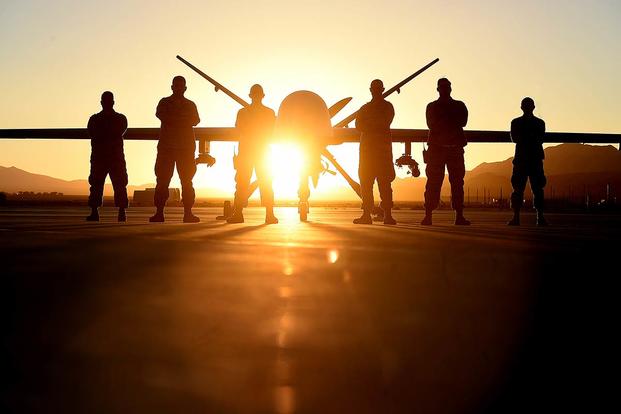The U.S. Air Force plans to increase the number of fighter pilots in its ranks by as much as 20 percent a year in part by using more F-16 and trainer aircraft for the job.
The service also said it plans to boost the number of drone pilots by training enlisted airmen to fly the high-altitude spy drone RQ-4 Global Hawk.
The Air Force wants to increase the number of fighter pilots it trains each year to 1,375 officers, officials announced Monday at the Air Force Association's annual Air, Space & Cyber Conference in National Harbor, Maryland.
"That's about a 15 to 20 percent increase," Brig. Gen. Andrew Croft, director of plans, programs and requirements for Air Education Training Command, told reporters during a briefing. "We're on that ramp right now."
Check out Military.com's coverage of the AFA's Air, Space & Cyber conference.
The plan includes increasing the number of pilots "on the T-38 track," which will allow them to train for multiple missions but also be absorbed back into the fighter pilot mission should the Air Force need them, he said.
In the next few years, the T-X will replace the T-38 Talon, first produced by Northrop Grumman Corp. in 1959.
"Long range, we think the T-X is going to bring capability that will allow us to probably shorten undergraduate pilot training, so a shorter [program] means we're going to get pilots to the field a little bit quicker," said Lt. Gen. Darryl Roberson, AETC commander.
The T-X program, called the advanced fighter pilot training program, aims to replace 431 of the Air Force's Talons with 350 new T-X jet trainers. The program will cost the service $628 million over the next five years, Roberson said.
Companies including Northrop, Boeing Co., Lockheed Martin Corp. and Raytheon Co. are vying to build the trainer, which is slated to reach initial operating capability in 2024. But the entire fleet won't be part of the service until 2034, he said.
Meantime, the Air Force's two squadrons of F-16s from Hill Air Force Base, Utah, that will be "farmed out" to other bases, including Guard and Reserve locations, "have now been designated to come to AETC and so we're going to plus up the number of fighter pilots that we can produce using those F-16s, as soon as we can get them on," Roberson said.
The Air Force in August announced it will conduct site surveys to move the F-16s at Hill in preparation for the F-35. The service will choose from Luke AFB, Arizona; Holloman AFB, New Mexico; Joint Base San Antonio-Lackland's Kelly Field Annex, Texas; and Tucson Air National Guard Base, Arizona.
"At fighter formal training units, we're going to increase the percentage of fighter pilot production right away from 10 to 20 percent depending on what those units are able to do to start producing more fighter pilots across the board," Croft said.
The challenge will be time.
The Air Force can start this today, but the pilot might not be out there for two years, Roberson said. The number of instructors will need to match the pool of pilots undergoing training, and it will be difficult "to pull people out in the combat environment" back to conduct training, Croft said.
Drone Pilots
"[There was] huge effort over the last year to double the production of our remotely piloted aircraft pilots, and I am very happy to say that we have achieved that," Roberson said. "We are now producing 24 RPA pilots with every class … that we graduate, double from what we were doing not long ago."
Roberson said the Air Force has produced 700 drone pilots to date -- and the service has met both its fiscal 2016 and 2017 quotas.
The training itself, roughly six months at Joint Base San Antonio-Randolph, then propels pilots toward four to five months of training within their formal unit for combat operations.
"Our first enlisted RPA students will be beginning our [undergraduate training] program next month … the plan, right now as we have it, is approved for three enlisted pilot initial classes, what we're calling EPIC, of four students each," Roberson said.
Faced with high operational demand and a pilot shortage, the Air Force earlier this month announced plans to open to all career fields the job of steering the high-altitude spy drone made by Northrop, based in Falls Church, Virginia.
The training given to the enlisted pilots flying the RQ-4 Global Hawks, approved in 2015, will be exactly the same as officers receive. Roberson said the four new enlisted enrollees beginning classes Oct. 1 are "very experienced and familiar with RPA operations … these are tech[nical] sergeants, master sergeants, who are either already sensor operators or other RPAs or are very familiar with the operations that occur."
But in just a few class rotations, Roberson said, the service will also bring in airmen with little to no experience in RPAs so that we "get the full gambit."
"Each enlisted pilot that comes in will replace what would have been an officer so it's not additive, it's replacement, but I think this is actually going to help with recruitment," he said. There has not been a "significant trend" of airmen from one Air Force Specialty Code over another signing up for the job, Roberson added.
-- Oriana Pawlyk can be reached at oriana.pawlyk@military.com. Follow her on Twitter at@Oriana0214.
Related Video:
US Air Force Pilots | 5 Things You Don't Know




























